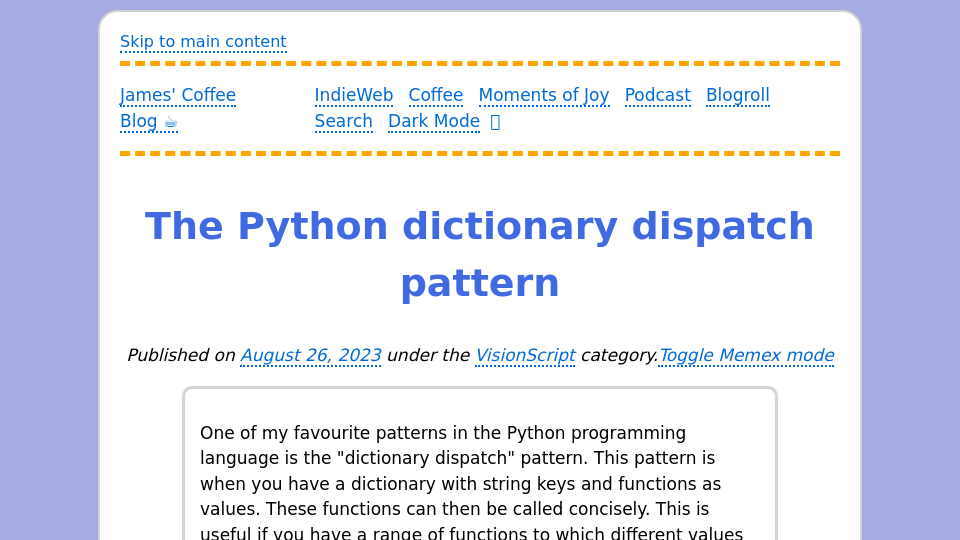To be honest, for me it looks as very strange pattern… If one wants to have static container with functions, there is Enums or classes.
It’s most useful when you’re using some data you already have as the dictionary key. A usecase i had for this was a binary file parser with 10 types of event markers. It was originally coded with if/elif, but performance was a pretty big consideration. Using the event markers as keys to a dictionary dispatch improved performance by about 15% and made the code significantly more readable.
With classes you needs getattr in python to achieve the same. This is cleaner for simple mappings
not unique to python.
function pointers and hashmaps exist in basically all languages
like in lua:
local table = { add = function(a, b) return a + b end } table["add"](4, 5)JavaScript:
{ add: (a, b) => a + b }Rust (using hashmaps with string keys is extremely inefficient tho, there are much better options here but whatever)
let map = HashMap::from([ ("add", |a, b| a + b), ]); //... map["add"](1, 3);I think a similar result might now be achievable with match statements
Match only just came out in Python 3.10, so it doesn’t universally work. I think you implied that in your comment, so I wanted to add context for others.
Oh, yes. I’m excited for the arrival of match. I’ve used it in rust and it’s very nifty and Pythonic
This is fun to play around and basically what Python does under the hood to implement classes. In Python2 it was even more obvious that classes are just fancy wrappers around a dict called, unsurprisingly,
__dict__.class Foo: def __init__(self): self.__dict__["instance_method"] = lambda: "instance_method" self.__dict__["shadowed_class_method"] = lambda: "shadowed_class_method_from_instance" Foo.__dict__["class_method"] = lambda cls: "class_method" Foo.__dict__["shadowed_class_method"] = lambda cls: "shadowed_class_method_from_class" f = Foo() f.__dict__["dynamic_instance_method"] = lambda: "dynamic_instance_method" print f.instance_method() print f.dynamic_instance_method() print f.class_method() print f.shadowed_class_method() OUTPUT: instance_method dynamic_instance_method class_method shadowed_class_method_from_instanceNote: this won’t work in Python3 because the
class.__dict__becomes immutable at some point after declaring it, but the attribute name resolution stays the same. And it gets more interesting once you throw inheritance into the mix.Broadly, this is a simple version of the Strategy Pattern, which is incredibly useful for making flexible software.
In Python, the example given is basically the classic bodge attempt to emulate switch-case statements.
My favorite way to implement this is with decorators. I used this to make a dispatch table for reading objects from a MySQL database.
(Yes I know I should be using UserDict below. You should too and don’t subclass dict like I did.)
class FuncRegistry(dict): """Creates a registry of hashable objects to function mappings.""" def __init__(self, *args, **kwargs): super().__init__(*args, **kwargs) def register_for(self, key: Hashable) -> Callable: """Decorator to register functions in the registry. Parameters key: Hashable The key which should point to this function Returns: Callable Returns a decorator that registers the function to the key""" def decorator(fn: Callable) -> Callable: self[key] = fn return fn return decorator qreg = FuncRegistry() @qreg.register_for('foobr') def handle_foobr(arg1, arg2): # do something here then return qreg['foobr']('ooo its an arg', 'oh look another arg')edit: formatting
deleted by creator







